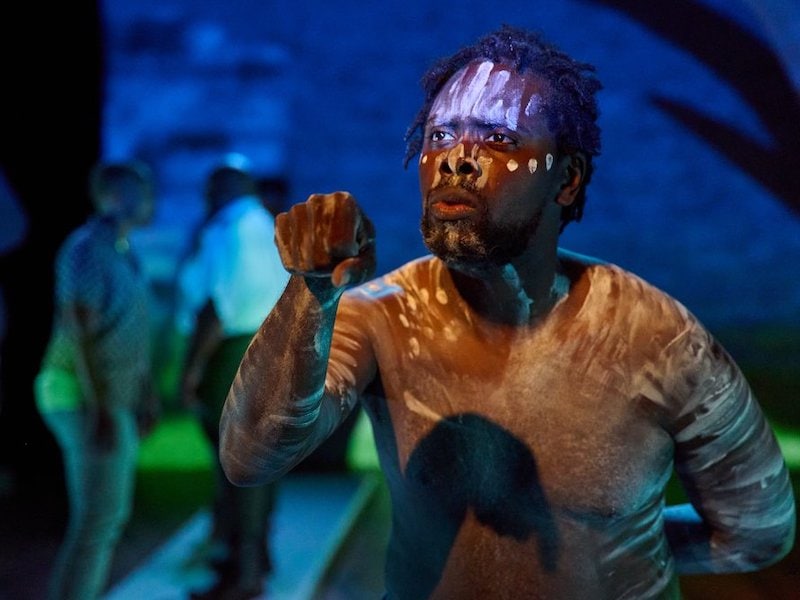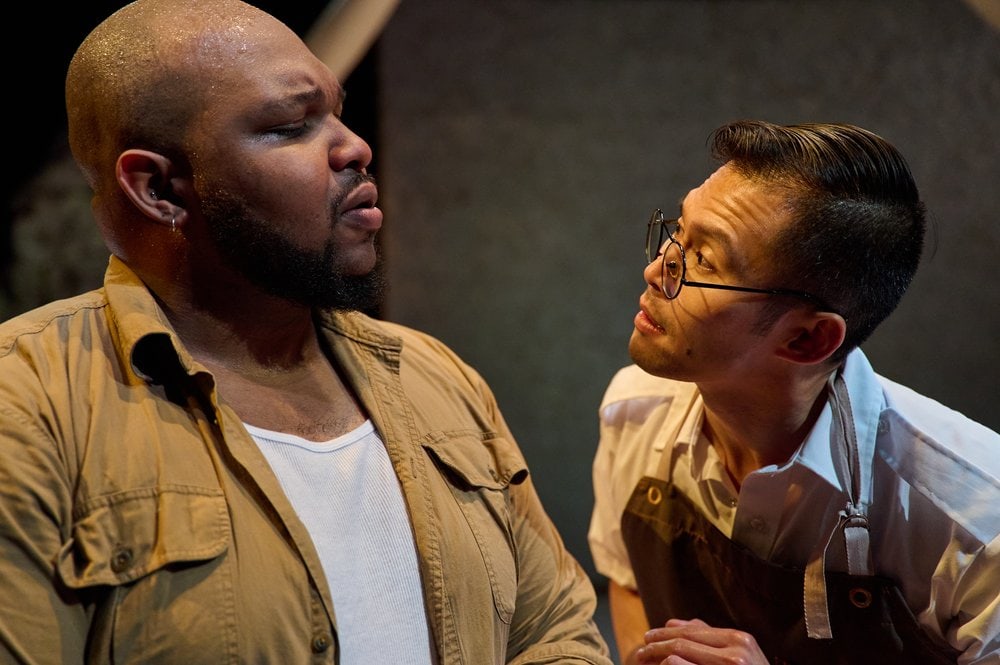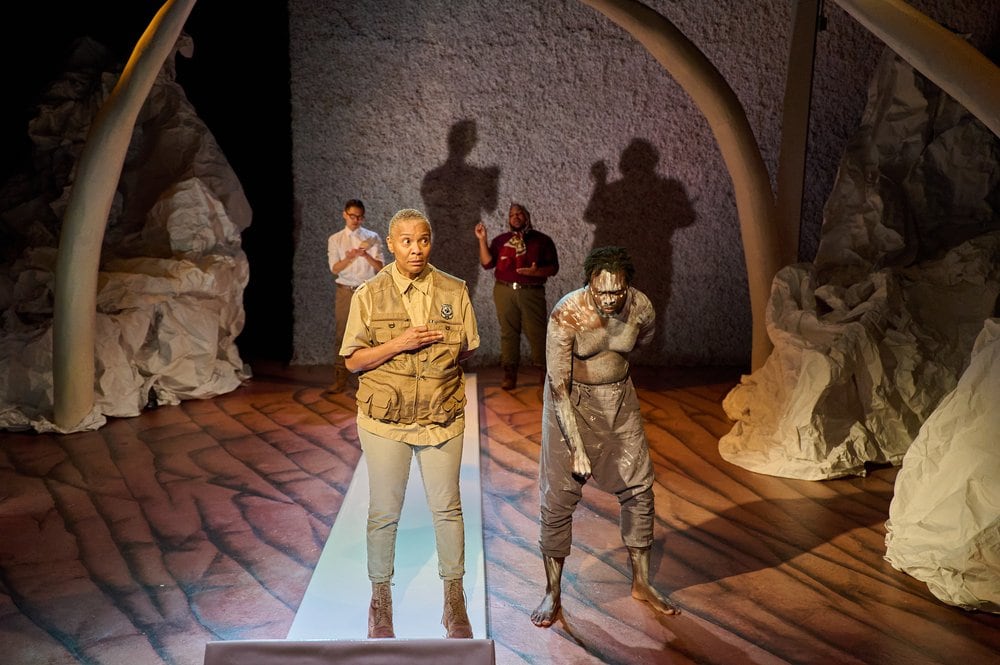Mlima — the name means “the mountain” — is one of the last of the “big tuskers”: magnificent elephants whose huge tusks are coveted for the profit and prestige they can bring. Mlima’s tusks are the only aspect of his being that is valued by those human beings who are not of the same land and culture that he is (“white infidels” one of the poachers calls them). Geedi, the experienced poacher explains it to his inexperienced helper: “[My father say] it is a creature to be respected, you must look it in the eye as it die. Give it the honor of knowing the hand that sent him to the other side… He teach me hunger be the only reason to kill.”

Contrary to what his treatment by the white infidel might lead us to think, Mlima (as the playwright Lynn Nottage shows us in the monolog he delivers at the opening of Mlima’s Tale, now at 1st Stage) is a noble and intelligent being who has connections to a community of equally noble and intelligent fellow elephant travelers. The connections among them are expressed through the responsibilities the members of that community share: to communicate with each other, to give each other information about the lay of the land (what food is where, what water), to respond to one another in times of trouble. They have the responsibility to pass on to subsequent generations the knowledge about how they have survived so long, as when Mlima says:
When I was young I was taught by my grandmother to listen to the night. Really listen… because how you listen can mean the difference between life and death… She’d say if you really listen, our entire history is on the wind.
This community of elephants represents an entire, almost timeless, culture that is under siege.
While Nottage anthropomorphizes Mlima through her words, Mlima’s magnificence is given a palpable and powerful embodiment by actor Jeremy Keith Hunter, whose deeply committed performance anchors this production.
Mlima is illegally hunted down and killed. But it is not the technical illegality of the hunting and killing of an elephant that is so much the center of this story. What the play portrays most feelingly is the soullessness — the inhumanity, venality, and cruelty of the people and systems that maintain this practice. In sharing the story of Mlima’s plight, Nottage lays out for us the internecine connections among race, ecopolitics, and capitalism as manifested in this particularly bloody butchery of an industry of killing and theft.
Not to put too fine a point on it, but at its heart, Mlima’s Tale is the story of the targeted destruction and manipulation of Africans and the culture(s) and the resources of the African continent by everyone else, including most recently, as shown in this play, by the Chinese: The targeting and destruction of Mlima stands in for all of this. As one character notes: “Africans don’t buy tusks.”
In telling this story of global illicit ivory trade, we are shown the poverty of the people who need the income that the tusks provide. Once the death of the elephant is discovered, our attention is brought to the tightened border surveillance that is imposed in order to find the poached tusks and prevent them from being exported and profited from. We experience the market for tusks that is driven by the super-wealthy, who seem to be above the law; the inadequacy of efforts to catch the perpetrators in the face of subversion of those efforts, a subversion made inevitable by the operation of a ubiquitous and overwhelming capitalism.

However, Mlima’s Tale is not a piece of anti-poaching agitprop. It is not a documentary. It is not social realism. You do not need to attend this performance prepared for a debate. Nor will you leave the production prepared for one.
Mlima’s Tale is the opposite of social realism. One could call it poetic, which it often is. But it is even more like a dreaming, an exorcism, a cleansing. It feels like a ritual that is almost hypnotic and trance-inducing in the rhythms of its language. It summons up the connections — invisible and across long distances — to spirits, ancestors, and the land.
There is something in Aboriginal culture called “a songline, also called a dreaming track,…one of the paths across the land (or sometimes the sky) within the animist belief systems…which mark the route followed by localized ‘creator-beings’ in the Dreaming.” The process that Mlima’s journey takes us through — as he is simultaneously dead, yet present in everything we experience — is similar to the dreaming track: the songlines.
Director José Carrasquillo’s staging of Mlima’s Tale supports this dreaming, rhythmic quality of the piece as characters enter and exit scenes, changing personas, seeing each other or not seeing each other, in much the way they do in dreams. Mlima’s ability to alternate his messages between his captor/killers (“If you’re listening, remember, I was once a proud warrior, unafraid to be seen”) and his relatives (“Koko Mkimbiaji if you’re listening. Don’t come looking for me, my brother. Remember what I told you the last day of the rains. Let reason rule your anger, and don’t come to mourn me! Run! Run!”) propels us into and holds us in this dream state. There is a scene when Mlima’s tusks have been installed in the foyer of the “perfect buyer” (someone who can afford to buy them, whose morals are not in conflict with the purchase and who has a suitable capacity for discretion in the handling and display of the purchase). Upon the unveiling of the tusks, the guests and the homeowners applaud in slow motion with arms raised to the skies. What is this applause in praise of? The accomplishment of being able to produce and retain wealth? The awe-inspiring work of a master craftsperson? As it is staged here it is also reminiscent of idolatrous rituals recounted in biblical scripture. It is a beautiful and chilling moment in the dream that continues to unfold onstage.

The set (Giorgos Tsappas) uses massive tusks to place us and the action of the play deeply inside Mlima’s carcass. Jeremy Keith Hunter’s body seemed to be inhabited by Mlima himself. Hunter’s breathing and groaning resonated from the localized actor and were reflected from the monumental carcass that was the set. Hunter’s arm and hand allowed Mlima’s trunk to articulately express his nonstop curiosity and desperate need to know where he was, what was happening around him, and his determination not to give up until his last breath.

Each of the performers has noteworthy moments. The scene between Deirdre Lawann Starnes as the super-rich wife who is looking for just the right piece of art to exhibit in the foyer of their newly built home, and Andrew V. Ly as the gallery owner who delicately negotiates both whether this is the perfect buyer for this piece and what the appropriately expensive price for it should be was memorable. The mutual flattering of taste and the appreciation and acknowledgment of the buyer’s access to the means of satisfying it was a titillating exchange. Shaquille Stewart as the man in charge of the ship transporting the ivory tusks, sincerely lying through his teeth, had me so confused that I almost believed him.
Mlima’s Tale is a cautionary tale, not a hopeful one. The play closes with Mlima repeating his pleas to his acquaintances to refrain from trying to find and save him as their relationships with him might otherwise demand. Rather, from within the depths of his cavernous mounted carcass he howls: “Run!” For those that have ears to hear, let them hear.
Running time: 90 minutes without intermission.
Extended: Mlima’s Tale plays through October 9, 2022, at 1st Stage, 1524 Spring Hill Road, Tysons, VA. To purchase tickets ($15–$50), go online or call 703-854-1856.
The program for Mlima’s Tale is downloadable here.
COVID Safety: All patrons, volunteers, and staff are required to be masked while inside the 1st Stage Theatre facility. See 1st Stage’s complete COVID Safety Information here.
Mlima’s Tale
Written by Lynn Nottage
Directed by José Carrasquillo
CAST: Jeremy Hunter (Mlima), Deidra Lawan Starnes (Ensemble), Andrew V. Ly (Ensemble), Shaquille Stewart (Ensemble)
CREATIVE TEAM: Set Design by Giorgos Tsappas, Costume Design by Moyenda Kulemeka, Sound Design by David Lamont Wilson, Lighting Design by Sara Tundermann, Stage manager by Hanna Smaglis, Projections Design by Jon Roberts




